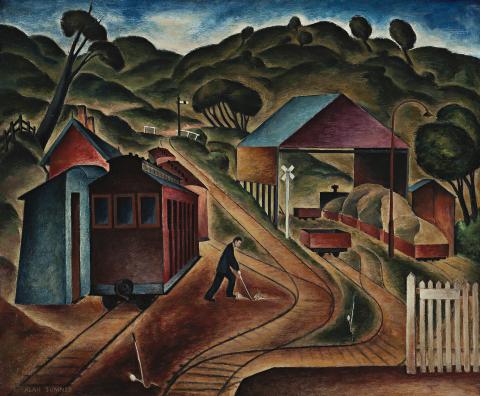HILL TRAIN TERMINUS FERNTREE GULLY, 1948
ALAN SUMNER
oil on canvas
63.0 x 76.0 cm
signed lower left: ALAN SUMNER
Golden Age Gallery, Ballarat
James Agapitos and Ray Wilson, Sydney
Gregson Flanagan Fine Art, Perth, 14 October 1996, lot 73
Private collection
Gregson Flanagan Fine Art, Perth, 27 July 1999, lot 11
Private collection, Tasmania
Melbourne Contemporary Artists, Athenaeum Gallery, Melbourne, 5 – 16 October 1948, cat. 46 (as ‘Hill Train Terminus’)
Alan Sumner: Retrospective Exhibition 1933-83, McClelland Gallery, Melbourne, opening 5 June 1983, cat. 18, then; Golden Age Gallery, Ballarat, 17 July – 21 August 1983, cat.43
Alan Sumner (retrospective), National Gallery of Victoria, Melbourne, 26 October 1993 – 7 February 1994, cat. 19 (label attached verso)
Badham, H., A Study of Australian Art, Currawong, Sydney, 1949, pl. 110 (illus.)
Alan Sumner, National Gallery of Victoria, Melbourne, 1993, cat. 19, pp. 4 (illus.), 6
Hill Train Terminus, 1948, colour screenprint, 41.7 × 50.8 cm image, edition of 38, collection of the National Gallery of Australia, Canberra and the National Gallery of Victoria, Melbourne, see Butler, R., Alan Sumner – Screenprints, Eastgate Gallery, Melbourne, 1993, cat. 50, (illus. on cover), pp. 96, 97 (illus.)
In a newspaper interview in 1990, Alan Sumner reflected on his extensive career, commenting ‘(m)y work is about anticipation, the next step, the stillness between what is to happen next … about people just waiting.’1 This deliberate mood of suspended animation haunts Hill Train Terminus, Ferntree Gully, 1948. Glimpsed as if from a passing carriage, the viewer’s eye immediately fixes on the lone figure caught in the act of switching tracks, a task we assume was completed but will never witness. All around is a contrasting sense of agitation, through the sweeping lines of the tracks themselves, the windswept trees and the rearing bulky forms of the train and shed. It is a remarkable composition that bears all the hallmarks of both Sumner’s extended studies with the modernist George Bell, and his allied career as a prolific stained glass designer.
By 1948, when Hill Train Terminus, Ferntree Gully was painted, Alan Sumner had been teaching at the National Gallery School for two years after being de-mobbed from the Royal Australian Air Force. Prior to this, he had studied extensively with George Bell and worked at E.L. Yencken & Co.’s stained glass company under the tutelage of the artist William ‘Jock’ Frater. 1948 too was the year that his painting Lysterfield Landscape, c.1946 was awarded the George Crouch Memorial Prize at the Ballarat Art Gallery; and was also the time when Sumner emerged as an Australian pioneer of fine art silkscreens. As such, this painting dates from one of the most fertile periods of the artist’s career. Shortly after its first exhibition, the Sydney artist Herbert Badham reproduced Hill Train Terminus, Ferntree Gully in his influential publication A Study of Australian Art. 2
Sumner’s paintings are not only imaginative and satisfyingly designed; they are also scrupulously crafted having started as plein air sketches before being reworked in his Collingwood studio. Apart from the technical skills gleaned from George Bell, Sumner made numerous experiments with media whist perfecting his own silkscreen process, stating ‘I had to be my own chemist and invent my own paint from a little of this and a little of that, the earth colours for preference. Each colour was put out in a jar on the roof in the sun to test its permanency. Many were rejected as fugitive. Many oils were also tested in the sun in this way and beautifully pure stand oils resulted.’3 This same level of precise experimentation naturally informed his paintings which are constructed with meticulous attention to their material qualities. Sumner subsequently printed a silkscreen version of Hill Train Terminus which he considered the most ambitious from the series of fifty – and its culmination.
1. Trioli, V., ‘1940s art retains impact’, The Age, Melbourne, 17 September 1990, p. 14
2. Badham, H., A Study of Australian Art, Currawong, Sydney, 1949
3. Sumner, A., quoted in Butler, R., Alan Sumner – Screenprints, Eastgate Gallery, Melbourne, 1993, p. 16
ANDREW GAYNOR
